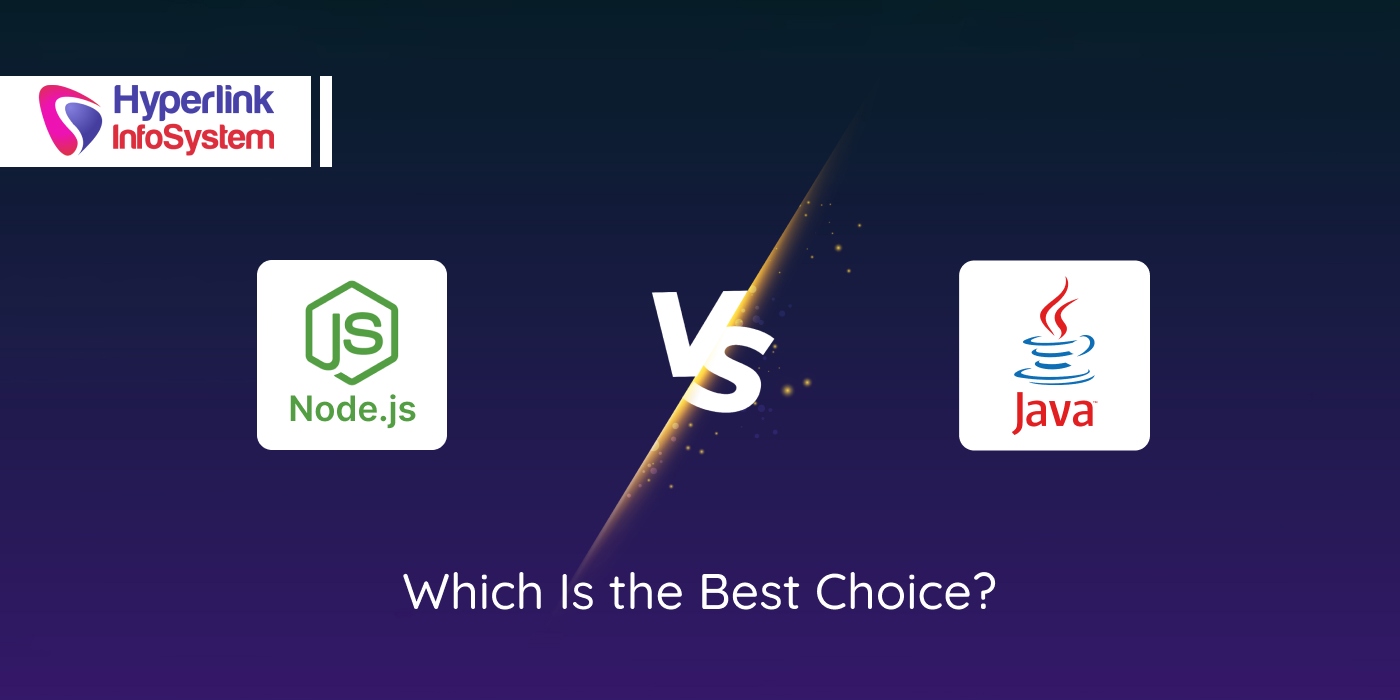Node.js vs Java: Which Is the Best Choice for Businesses?
Oct 2025

When we mention Java and Node.js in the developer community, it evokes similar responses. Both are praised for their scalability, versatility, high performance, and extensive ecosystems, featuring numerous libraries and frameworks. Java is an old-timer that has been in existence since 1995. It has helped innumerable companies create complex apps and solutions, especially in the banking and finance sector. Check out the Reddit forums, and you won’t be surprised to see a Java vs. Node.js debate.
In comparison to Java, Node.js is a late entrant in the development market. Still, it has garnered a huge fanbase owing to its scalability, ability to handle multiple users simultaneously, and cost-effectiveness. This brings us to the million-dollar question. Between Node.js and Java, which is better for development?
Node.js, which is a runtime environment, still gives stiff competition to Java, despite not being a programming language. This blog post is not just a regular Java Vs. Node.js comparison goes beyond the pros and cons, discussing when to use them and more. Enough talking, let’s get started.
What Is Node.js?
A software engineer named Ryan Dahl observed major shortcomings and issues in commonly used server-side technologies. Firstly, none of these technologies could handle several requests at the same time. Additionally, developers had to painstakingly use more than one language to handle client and server-side development. This led to Ryan creating Node.js in 2009.
Ryan used Google’s V8 JavaScript engine as the base for Node.js. Unlike traditional server environments like Python, which stops handling other requests while handling a complex operation (say, for example, teaching APIs), Node.js uses a feature called multithreading that moves to other tasks while working on the complex task in the background.
This brings us to the million-dollar question: Why is Node.js a celebrity in the development world? It is because Node.js allows developers to share and reuse code. When working on complex projects, writing code from the bottom up requires a great deal of time and effort, which increases the time to launch and deploy the app.
Developers solve this problem by using a hack within the Node.js ecosystem, known as npm (Node Package Manager), which has more than 800,000 code packages. In simple language, these packages are built-in tools and packages that accelerate product time to market. For developers, it means less time spent on coding and better results.
Key Features of Node.js
Now that we know what Node.js is and why it is gaining increased popularity, let us explore some of its key features.
- Fast Performance - Uses Google’s V8 engine, making it easier for it to translate JavaScript code.
- Non-Blocking I/O - Handles multiple requests simultaneously without sacrificing speed or performance.
- Single-Threaded and Event-Driven - Uses a single thread to handle multiple tasks, but doesn’t sacrifice efficiency as it relies on an event loop.
- Cross-Platform - Works on all platforms, including Windows, macOS, and Linux.
- Community Support - Massive ecosystem with regular updates, tools, and contributions from developers around the world.
- NPM Support - Node.js comes with a Node Package Manager that allows users to access millions of built-in modules.
- Scalability - Provides companies with the necessary scalability to handle thousands of users simultaneously.
- Single Language for Front and Backend - Developers can use Node.js for both the backend and frontend, ensuring faster development and improved collaboration.
Pros and Cons of Node.js
|
Pros |
Cons |
|
Non-blocking I/O and an event-driven model are great for handling thousands of requests simultaneously without heavy threads |
Single threads are not ideal for CPU-intensive tasks. Worker threads or offload tasks can fix this. |
|
Single language for frontend and backend reduces context switching while improving team collaboration |
Older versions of Node.js required many callbacks to handle asynchronous tasks, making code messy and unmanageable. |
|
Huge ecosystems with 2 million+ packages. Users can solve most problems using community libraries. |
Some packages can be of sub-standard quality, outdated, poorly documented, or insecure. They may require dependency checks. |
|
WebSockets and an event-driven model are great for real-time apps such as chats, live feeds, multiplayer games, and dashboards. |
Failure to handle errors within asynchronous code can cause app crashes. |
|
Scalable architecture allows for efficient request handling and horizontal scaling. |
The npm ecosystem is vulnerable to attacks. Requires constant updates, audits, and dependency scanning. |
|
JavaScript, being native to JSCON, makes data flow smooth between front-end, backend, and NoSQL DBs. |
Rapid changes to the Node.js ecosystem include evolving tools and frameworks. Makes it harder for beginners to grab concepts and use them. |
|
Has a wealth of developer tools for linting, testing, bundling, and monitoring, along with an active open-source community. |
Not the best choice for apps requiring heavy processing, strict rules, or complex calculations. TypeScript is a solution, but it is hard to learn. |
Thinking about using Node.js for your next project? Consider partnering with a reputable Node.js development company for the best results.
What Is Java?
In 1995, Sun Microsystems introduced Java to the world, thanks to James Gosling and his team’s combined efforts. Fast-forward to 2025, and Java has been going strong for 30 years. Java does not need a specific device to work; it works on any device with the Java platform installed. So, developers only have to write the code once, and it works seamlessly on any platform or device. On top of that, Java’s use spans across multiple sectors, owing to its scalability, reliability, and top-notch community support.
In simple language, Java is a programming language where developers use real-life concepts to create robust code. When coding with Java, developers follow the object-oriented approach, where they think of components and entities as objects. This is known as the object-oriented programming approach. To put it in simple language, Java developers use real-life concepts to create code. This is called the object-oriented approach within the Java developer community.
This approach involves simplifying concepts by breaking them down into simpler concepts to build complex, scalable, and high-performance systems. Many sectors, including healthcare, banking, and finance, gather, analyze, and use vast data sets to achieve their business goals, but security and reliability remain a major concern for them. Java emerges as a savior for such companies.
Regardless of the project size or complexity, Java provides developers with the basic, foundational blocks to manage them from start to finish. Thanks to Java, developers don’t have to slog, writing each piece of code from zero because it offers a vast assortment of reusable components and frameworks.
Java’s use cases include the following:
- Developing enterprise software for large businesses.
- Ensuring the functioning of Android apps on smartphones.
- Powering web apps, games, and servers.
- Supporting cloud computing and big data tools in existence.
Java’s ever-evolving nature is the reason Java remains relevant to this day, plus it embraces new and emerging technologies such as AI, big data, and cloud computing.
Key Features of Java
After a brief overview of Java, it is time to look at some of its key features.
- Simple - Easy learning curve devoid of complications like its precursors.
- Object-Oriented - All entities in Java are defined as objects and classes with unique state and behavior.
- Platform Independent - Not code dependent, developers can convert Java code into bytecode and run it on any system with a JVM installed.
- Portability - Thanks to the write once, run anywhere concept, Java runs smoothly on multiple platforms and devices.
- Robust - Exception handling and automatic garbage collection mean fewer crashes and memory issues.
- Security - In-built features such as classloader and security code protect the app and system from malicious code or unsafe actions.
- Simplified Syntax - Clean, simple, and easy-to-use syntax for beginners and experienced developers alike.
- Multithreaded - With Java, developers can execute multiple tasks simultaneously, resulting in speedy and efficient development.
Pros and Cons of Java
|
Pros |
Cons |
|
Platform Independent (Write once, run anywhere) |
Slower than languages such as C/C++ due to JVM overhead. |
|
Object-Oriented (easy to model real-world problems) |
Requires significantly more memory (not lightweight) |
|
Strongly typed and secure (reduces bugs and is safer for enterprise apps) |
Verbose syntax (more lines of code compared to Python and JavaScript) |
|
Massive and thriving community plus extensive libraries (support, frameworks, and tools) |
Steeper learning curve for beginners |
|
Scalable (suitable for small to enterprise-level apps) |
GUI development is old-fashioned compared to newer languages and frameworks. |
|
Offers backward compatibility (old code usually runs on new versions) |
Performance-heavy for low-level or real-time systems |
|
Rich Ecosystem (Spring, Hibernate, Android development) |
Slower adoption of new features compared to newer and more popular languages. |
Does the thought of building a Java-powered app excite you? Implementing Java for your next project requires a structured and well-thought-out strategy. Consider hiring a Java development services company for a faster time to market without spending a fortune.
Key Differences between Java and Node.js
Both Java and Node.js share some common features, but don’t be fooled by them. They are as different as they are similar. Java is a programming language based on JVM, and its structure is best suited for managing huge volumes of data and sophisticated products. Common use cases include airline companies, banks, and online shopping portals, where smooth, hurdle-free operations are crucial for business success.
Another reason for Java’s immense popularity is that Java-powered solutions stand the test of time. In many cases, Java-based systems have worked without any issues for over ten years. At the same time, handling concurrent tasks without compromising accuracy is a breeze with Java.
Unlike Java, Node.js is not a programming language. If truth be told, it is a runtime environment that generally runs on the browser. Companies use Node.js to run JavaScript outside browsers, including backend and frontend interfaces. One of the main reasons for Node.js' unparalleled efficiency is the V8 engine that powers it. No wonder companies choose it for input/output-heavy APIs and real-time apps.
Below are the key differences between Java and Node.js.
|
Aspect |
Java |
Node.js |
|
Type |
Programming language |
Runtime for JavaScript |
|
Typing |
Statistically typed (safer, but requires more lines of code) |
Dynamically typed (faster to write but error-prone unless TypeScript is used) |
|
Execution Model |
Multi-threaded (true parallelism) |
Single-threaded event loop (asynchronous, non-blocking I/O) |
|
Best For |
CPU-intensive tasks, enterprise apps, and banking systems |
I/O-heavy tasks, real-time apps, and quick APIs |
|
Performance |
High-performance computing |
High performance for handling many connections |
|
Ecosystem |
Mature, stable, and enterprise-grade tools (Spring and Maven) |
Fast-growing, with web-focused tools (Express, NestJS, npm) |
|
Deployment |
JAR/WAR, JVM, and containers |
JS/TS and containers |
|
Learning Curve |
Steeper but structured learning curve |
Easier to start learning and more flexible |
The Java vs NodeJS battle is never-ending, but companies must make the right choice by considering the pros and cons and specific business goals.
When to Use Java and Node.js?
The decision to choose Java or Node.js depends on the nature of the project, specific objectives, and developer expertise. Below are scenarios where Java and Node.js work best.
When to Use Java?
Java is the best bet under the following scenarios:
- Enterprise Apps - Sectors such as banking, insurance, and healthcare require extensive and complex systems while prioritizing reliability and long-term stability.
- High-Performance Backends - Systems that require multi-threading, execution of multiple tasks, and processes, or CPU-intensive tasks. Examples include trading platforms.
- Android Development - Although Kotlin is the preferred language for Android development, Java still enjoys a decent reputation.
- Scalable & Durable - Certain sectors, such as telecom, logistics, and government, want systems to last for decades and operate with older versions.
- Stringent Security - Financial services, identity management, and military-grade apps require stringent security measures.
- Cloud and Microservices - With frameworks such as Spring Boot, Quarkus, and Micronaut, Java remains the top choice for building high-performance, reliable, and scalable apps.
When to Use Node.js?
Below are scenarios where Node.js is the best option.
- Real-Time Apps - Best choice for real-time, collaboration, and gaming apps due to its ability to handle a multitude of users and instant updates.
- Microservices and Serverless - Lightweight, economical, and top-notch performance make Java an excellent choice for serverless and microservices.
- Scalable Web Backends - Most startup companies and SaaS enterprises pick Node.js to build scalable backends that handle a substantial number of users.
- Simple Language Stack - For those companies that want a single language to power frontend and backend systems, TypeScript/JavaScript is the perfect fit.
- Prototyping and Startups - Developing and deploying MPVs using Node.js is effortless, thanks to its vast library consisting of pre-built modules and packages.
Future of Java and Node.js in 2025 and Beyond
Java and Node.js will have to evolve constantly to retain their spot. Let’s look at what the future holds for them and if they have the power to change the development landscape.
Future of Java
Major Releases
- Java 24 (March 2025) - Comes out with 24 new features, including Stream Gatherers and improved visual threads behavior.
- Java 25 LTS (September 2025) - Scheduled for release on Sept 16, 2025, with 18 JEPs lined up.
- Project Valhalla - Still in the experimental stage with a focus on language efficiency.
Cloud-Native and Microservices
- Increased focus on cloud development with Spring Boot, Quarkus, MicroProfile 7, etc.
- Quarkus 3.25.4 LTS (Aug 2025) - Optimized for Kubernetes and serverless optimizations.
- GraalVM (JDK 24) - Faster startup, lower memory usage, AOT, and polyglot support.
AI Integration
- Entry of AI into fraud detection, recommendation systems, and more with tools such as DJL, Tribuo, and LangChain4j.
- Spring AI and Model Context Protocol SDKs enable RAG, embeddings, and vector DB workflows.
- AI copilots will speed up development, but human intervention is necessary for accuracy, security, and to ensure that the solution solves real-world problems.
DevOps, Sustainability, and Security
- CI/CD and IaC via Jenkins, GitHub Actions, Argo CD, Terraform, and more.
- Security-first approach with a development process built around integrated scanning, secure authentication, and zero trust principles.
- Eco-friendly coding that uses less power and memory.
Future of Node.js
Speed, Security, & WASM
- Faster Apps - With Node.js 21, apps start faster, using less memory while handling multiple at the same time without compromising performance.
- WASM Support - Developers can run code using other languages such as Rust or C++ to ensure speed, reliability, and flexibility.
- Edge, Serverless, and Microservices
- Edge Computing - Companies can run Node.js close to the users’ location, which reduces delays and infrastructure costs.
- Microservices and Modularity - With every part of a Node.js app working as independent deployable services and separate modules, developers find it easy to scale, fix, and manage them.
APIs, Observability, and ES Modules
- GraphQL over Rest - Fetches only the necessary data, making APIs cleaner and faster.
- Observability - Tools like Open Telemetry provide valuable insights into Node.js systems.
- ES Modules - Modern import/export systems are compatible with frontend systems, plus that code remains stable for years.
AI, Deno, and Runtime Alternatives
- AI in Node.js - Using TensorFlow.js and Brain.js, companies can run AI models directly inside the browser. This results in predictions with greater accuracy, better image recognition, and tailored recommendations.
- Dino - Like Node.js, Dino is a secure runtime that can run TypeScript without the need for extra tools while boasting simplified dependency management.
Summing up, most companies choose Java to build complex systems, enterprise software, and cloud platforms. Also, lightweight and high-speed systems such as microservices have a strong preference for Java because it helps them handle innumerable requests without jeopardizing speed or accuracy.
Labelling either of them as outdated would be incorrect, as both of them evolve constantly by embracing AI and other cutting-edge technologies. Developers must learn to use Java and Node.js for specific use cases, meaning wherever they are required. This is important to get the best results.
The secret lies in using Java for large systems where security and reliability are paramount. Node.js should be used for edge-ready apps and projects that demand flexibility and speed. Confused about when to use Java and Node.js and how? Consult a reputed app development company for detailed guidance regarding implementation.
Conclusion
In the above sections, we tried to cover as many points as possible. The Java vs. Node.js debate is never-ending because there will always be people who pick a side and choose one over the other. Java is great for large systems and long-term projects, especially those involving vast volumes of data, a massive user base, and stringent security requirements. Systems built on a Java foundation are expected to run smoothly for 10 or more years.
In contrast, Node.js is perfect for real-time apps such as chats, live notifications, and streamlining apps and companies that want lightweight services, including API and microservices. Startups and enterprises that want to launch products faster or operate closer to their user base also opt for Node.js. In short, Node.js and Java have their strengths and limitations, with neither being superior to the other.
Companies must understand their goals, user base, scalability needs, and other factors before choosing a programming language. If you think all of this is too much work for you, consider outsourcing your app development needs to us. Hyperlink InfoSystem is one of the top Node.js development companies with a presence in over 4 countries. Speak to one of our experts to know more about what we can do for you.
Frequently Asked Questions
The cost of Java development services depends on the team and geographical location. Below are the region-wise costs for Java development services.
- USA - $60 - $120/hour
- Western Europe - $50 - $100/hour
- Eastern Europe - $35 - $60/hour
- India - $20 - $70/hour
- Latin America - $25 - $50/hour
The cost of Node.js development services depends on several factors, including project complexity, developer experience, location and hiring model, scalability and security needs, and tech stack, to name a few. Below are the region-wise costs for Node.js development services.
- USA and Canada - $75 - $150+/hour
- Western Europe - $60 - $120/hour
- Eastern Europe - $30 - $70/hour
- India and South Asia - $12 - $50/hour
This is quite a difficult question to answer, but we will still answer it. Compared to Java, Node.js is cheaper initially, with 10 to 30 percent lower development and infrastructure-related costs. It is best suited for startups, MVPs, and real-time apps. Talking about Java, it is more expensive at first, but it gets more predictable and stable in the long run. How does Java stack up against Node.js in terms of costs?
- 25% to 35% higher development costs compared to Node.js because of higher salaries, longer development cycles, and heavier frameworks.
- 15% to 25% higher infrastructure costs than Node.js due to JVM memory usage and larger instances.
- 10% to 20% lower maintenance costs after 5 years due to better backward compatibility.
Hyperlink InfoSystem is more than just an app development company. It has a great reputation for providing innovative services and developing products that defy the norm. So, to say we are one of the top Node.js development companies is an understatement. Adapting to new trends and technologies like AI, blockchain, IoT, and others makes Hyperlink InfoSystem compete with industry bigwigs and stay ahead of the curve.
Hiring Node.js developers requires a structured and planned approach. Below is the process to hire Node.js developers that companies should follow to hire the right candidate and complete complex projects without much stress.
- Define the project requirements, including goals, required skills, along with timelines, budget, and engagement model.
- Choose the best hiring model for the project - in-house, freelancing, outsourcing/agencies.
- Write a clear job description that includes the required skills, optional but preferred skills, along with seniority level, job role, and growth opportunities.
- Source candidates from multiple sources, including job boards, freelancing platforms, tech communities, and outsourcing partners/agencies.
- Screen candidate resumes by checking if they have relevant Node.js experience. Also, check for open-source contributions or project demos.
- Conduct technical screening by giving the candidates a practical assignment focusing on the basics, async and error handling, performance, and more.
- During the interview process, check for technical skills and ask scenario-based questions.
- Check for references and past work, and finish by making the final offer.
The above points can guide companies on how to hire Node.js developers, but every company is unique. Hence, it is crucial to tweak the strategies to find the right candidates for the project.
Hiring Java developers is not easy, but below is a step-by-step process to simplify the process.
- Define the project requirements with the complete scope, tech stack, and required experience.
- Choose the right hiring model from options such as full-time, contract, freelance, or outsourcing.
- Use popular job portals, referrals, or staffing agencies to source candidates.
- Evaluate the candidate’s skills, experience, and whether he/she has worked on similar projects before.
- Conduct a technical assessment involving coding tests and problem-solving skills.
- The interview process must include technical and behavioral assessments.
- Check for the candidate’s past work, projects, and client feedback.
- Make the final offer that encourages the candidate to take the job, finalize the contract, and give them the necessary tools and resources to perform their tasks.
The above points are just basic guidelines to help companies hire Java developers. However, every company is different, and so are projects. Hence, it is advisable to modify the process to suit specific company goals and requirements.
Node.js boasts a vast ecosystem consisting of several frameworks that accelerate and simplify backend, frontend, and full-stack development. Below are the top Node.js frameworks based on their uses.
- Express.js - Popular and minimalist.
- NestJS - Enterprise and scalable.
- Koa.js - Lightweight successor to Express.
- Fastify - Ultra-fast API framework.
- Hapi.js - Configuration-driven.
- Sails.js - MVC and real-time.
- Meteor.js - Full-stack JavaScript.
- AdonisJs - Laravel-like for Node.js.
- Loopback - API-first development.
- Strapi - Headless CMS on Node.js.
Latest Blogs

Is BlockChain Technology Worth The H ...
Unfolds The Revolutionary & Versatility Of Blockchain Technology ...


IoT Technology - A Future In Making ...
Everything You Need To Know About IoT Technology ...

Feel Free to Contact Us!
We would be happy to hear from you, please fill in the form below or mail us your requirements on info@hyperlinkinfosystem.com
Hyperlink InfoSystem Bring Transformation For Global Businesses
Starting from listening to your business problems to delivering accurate solutions; we make sure to follow industry-specific standards and combine them with our technical knowledge, development expertise, and extensive research.
4500+
Apps Developed
1200+
Developers
2200+
Websites Designed
140+
Games Developed
120+
AI & IoT Solutions
2700+
Happy Clients
120+
Salesforce Solutions

40+
Data Science

















